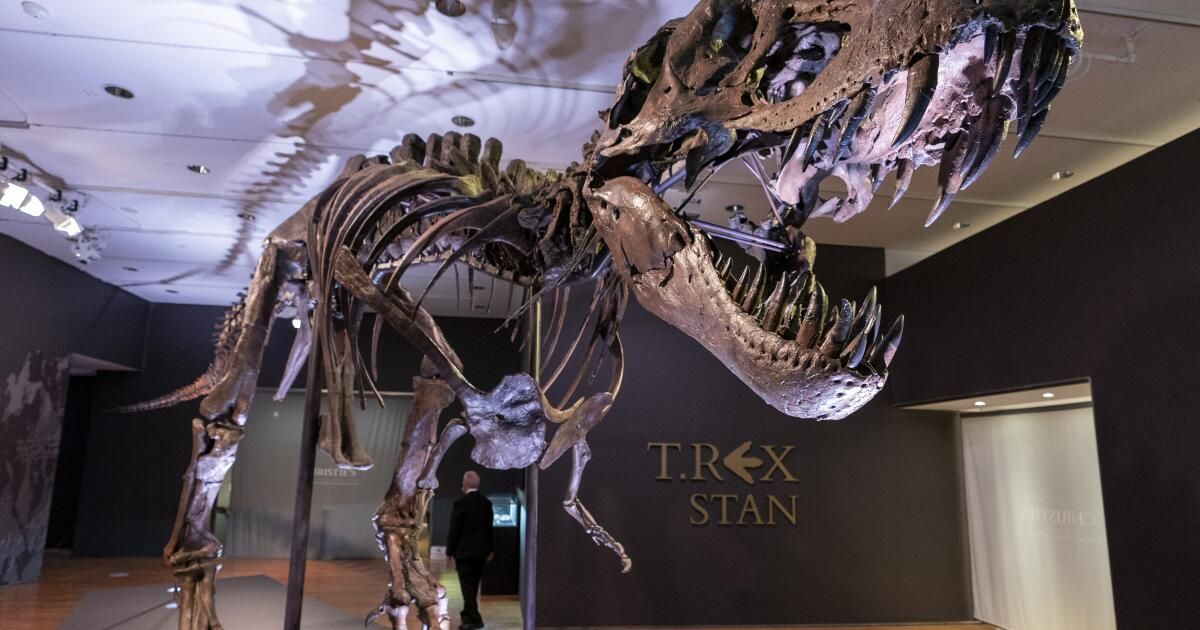In December 2022, Vanderbilt University neuroscientist Suzana Herculano-Houzel published a paper which caused a big stir in the world of dinosaurs.
After analyzing previous research on the brain cavities of fossilized dinosaurs and the neuron counts of birds and other related living animals, Herculano-Houzel extrapolated that the fearsome Tyrannosaurus Rex It may have had more than 3 billion neurons, more than a baboon.
As a result, he argued, predators could have been intelligent enough to make and use tools and form social cultures similar to those seen in today's primates.
The original “Jurassic Park” movie scared audiences by imagining velociraptors smart enough open doors. The Herculano-Houzel article described Tyrannosaurus Rex as essentially cunning enough to sharpen their own knives. The bold claims made headlines and almost immediately attracted scrutiny and skepticism from paleontologists.
in a paper Published Monday in “The Anatomical Record,” an international team of paleontologists, neuroscientists and behavioral scientists argue that Herculano-Houzel's assumptions about the size of the brain cavity and the corresponding neuron count were wrong.
TRUE Tyrannosaurus Rex The intelligence, scientists say, was probably much closer to that of modern crocodiles than to that of primates: a perfectly respectable amount of intelligence for a therapod.
“The thing to note is that reptiles are certainly not as dumb as is commonly believed,” said Kai Caspar, a biologist at Heinrich Heine University Düsseldorf and co-author of the paper. “So, while there is no reason to suppose that Tyrannosaurus Rex “It had habits similar to those of primates, it was undoubtedly an animal with sophisticated behavior.”
Brain tissue does not fossilize, so researchers examine the shape and size of the brain cavity in fossilized dinosaur skulls to deduce what their brains may have looked like.
In their analysis, the authors took issue with Herculano-Houzel's assumption that dinosaur brains filled skull cavities at a similar rate to bird brains. The Herculano-Houzel analysis postulated that Tyrannosaurus Rex The brains occupied most of their brain cavity, analogous to that of the modern ostrich.
But the dinosaur brain cases are more like those of modern reptiles like crocodiles, Caspar said. In animals such as crocodiles, brain matter occupies only 30% to 50% of the brain cavity. Although brain size is not a perfect predictor of neuron number, a much smaller organ would have far fewer than the 3 billion neurons Herculano-Houzel projected.
“T. rex “It turns out to be the dinosaur with the largest brain we studied, and the largest that is not closely related to modern birds, but we couldn't find the 2 to 3 billion neurons it found, even by our most generous estimates” said the co-author. author Thomas R. Holtz, Jr., vertebrate paleontologist at the University of Maryland, College Park.
What's more, the research team argued, neuron count is not an ideal indicator of an animal's intelligence.
Giraffes have about the same number of neurons as crows and baboons, Holtz said, but they don't use tools or display complex social behavior like those species do.
“Obviously, in the grand scheme of things, you need more neurons to create more thoughts and memories and solve problems,” Holtz said, but the sheer number of neurons an animal has can't tell us how it will use them.
“The number of neurons is actually comparable to the storage capacity and active memory of a laptop, but cognition and behavior are more like the operating system,” he said. “Not all animal brains run the same software.”
According to computed tomography reconstructions, the Tyrannosaurus Rex The brain was probably “a long tube that has very little cortical expansion like you see in a primate or a modern bird,” the paleontologist said. Luis Chiappedirector of the Dinosaur Institute at the Los Angeles County Museum of Natural History.
“The argument that a Tyrannosaurus Rex He would have been as intelligent as a primate, no. That doesn't make sense to me,” said Chiappe, who was not involved in the study.
Like many paleontologists, Chiappe and his Dinosaur Institute colleagues were skeptical of Herculano-Houzel's original conclusions. The new paper is more consistent with previous knowledge about dinosaur anatomy and intelligence, he said.
“I am delighted to see that my simple study using solid data published by paleontologists paved the way for new studies,” Herculano-Houzel said in an email. “Readers should analyze the evidence and draw their own conclusions. That's what science is all about!
When thinking about the inner life of Tyrannosaurus RexThe most important conclusion is that reptilian intelligence is, in fact, more sophisticated than our species usually assumes, the scientists said.
“These animals play, are trainable and even show excitement when they see their owners,” Holtz said. “What we found does not mean that Tyrannosaurus Rex he was a mindless automaton; but he was not going to organize a Triceratops rodeo or pass on stories about the duckbill that was SO BIG but got away.”












